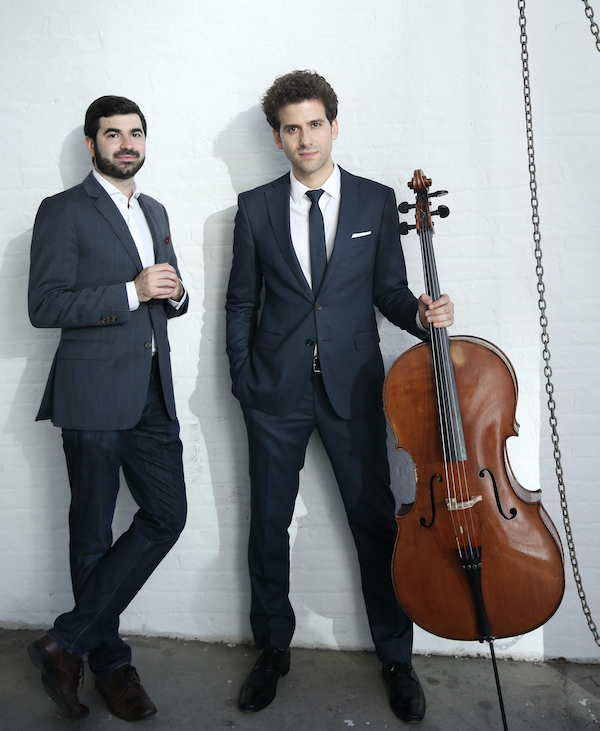Canellakis-Brown Duo brings skill, empathy to Grieg, Ginastera

The Canellakis-Brown Duo—cellist Nicholas Canellakis and pianist Michael Brown—have been playing together for ten years and it shows. Their concert Tuesday night at the Baruch Performing Arts Center was a superb display of the kind of assured, responsive, sincere playing that is a pinnacle of chamber music performance yet is more often heard in jazz and other music than in classical.
Canellakis and Brown are skillful instrumentalists and their frequent appearances in the Chamber Music Society of Lincoln Center attest to that. Yet beyond the technical demands, the duo showed great musical and personal thinking. Pieces like Grieg’s Cello Sonata in A minor—the most substantive work on the program—had tremendous shape, a chart of shifting experiences and levels of energy that grew organically and with the greatest logic out of the composition.
The program had a title, “Distinct Souls,” on which Canellakis and Brown hung the concept of music from different regions of the globe. It was generic enough to be both incontrovertibly accurate and fundamentally meaningless. If composers have souls (one hopes), they would by definition be distinct.
The music, through the duo’s playing, did all the explaining one needed. Besides the Grieg, the rest was a collection of rarely heard or surprising pieces—a recent work from Brown himself, and music by Alberto Ginastera, Reinhold Gliére, Sibelius, jazz musician and composer Don Ellis, and a traditional song related to Ellis’s piece.
The pair put great weight in the first half, opening with Ginastera’s Pampeana No. 2, Rhapsody for Cello and Piano, Op. 21. The immediate connection between Ginastera’s tango-tinged phantasmagoria and Grieg’s turbulent romantic journey was Canellakis’ wonderful tone production. He had a light touch in the tango parts of Ginastera’s Rhapsody, stretches that were a warm contrast to the convoluted inner landscape of the fantastical solo cello lines. This was music of many moods, distinct but not discrete.
The musical communication between the two was as relaxed and unselfconscious as a conversation between old friends at a bar—even in the toughest passagework, Brown’s playing sounded effortless and he himself had the manner of someone who was doing something he loved, and enjoying it in every measure.
After the mercurial Pampeana, the pair brought a poised gravity to Grieg’s Sonata. Their playing gave the music such presence and substance that the markers of form and style fell away before what felt like the essence of the works themselves. The first movement was so spirited that the audience immediately applauded, but even with that the sonata felt like a continuous communicative flow, not so much a formal structure of notes but a story.
Dark colors, and the sense of a brooding storm over the horizon, was the experience of the first half. After Brown’s neo-romantic Prelude and Dance—a companion piece to the the Bach Solo Cello Suites— opened the first half, that feeling was both cemented and tied off by the duo playing Sibelius’ Malinconia.
Canellakis introduced the music by pointing out that it came after the death of the Sibelius’s infant daughter. Rarely heard, this is one of Sibelius’ masterpieces. It has hints of music that would later be heard in the Fourth and Fifth Symphonies. Even more than the Fourth, it is full of dark turmoil, not just despair but rage. Canellakis and Brown were just understated enough that one felt the energy one needs to keep going through such an incomprehensible tragedy, and the stretches where the music climbed into sunlight felt fully earned.
Three of Gliére’s 12 Pieces for Cello and Piano, Op. 51—Cantabile, Con tristezza, and Con moto—let the ripples of anguish die away, then the pair finished with two exciting bits of Balkan music, Ellis’s Bulgarian Bulge and the traditional “Gankino Horo,” both arranged by Canellakis. The meters alone—the latter had 11 beats per bar, the former an astonishing 33—made this exciting, and the duo’s rhythms were terrific, fleet and fluid and with the right kind of bounce off of each accent.
The encore was Paganini’s Variations on a Theme by Rossini. Canellakis joked that the arrangement was by “some jerk” (it was the great cellist Pierre Fournier), because it requires the cellist to play all the music on the A string. Here is where Canellakis’s harmonics were so impressive, and the pair had great fun showing off their considerable chops.
The Clarion Quartet plays Shostakovich, Mendelssohn, and Weinberg, 7:30 p.m., March 17. baruch.cuny.edu/bpac